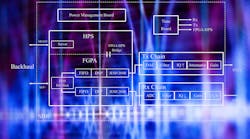Modern wireless networks have come to a crossroads as mobile users consume more data than ever before, with no signs of that trend abating anytime soon. Data consumption is crammed into an already overcrowded spectrum, which means less bandwidth for each user. The result is slower service and increasingly dropped connections.
Enter the millimeter-wave (mmWave) spectrum. This underutilized frequency spectrum is now being eyed as the answer to the bandwidth shortage. However, the ability to transmit large amounts of data isn’t the only trait that makes mmWaves so appealing. These waves are broadcast at extremely high frequencies, between 30 and 300 GHz, and those high frequencies can deliver faster wireless communication—exactly what 5G aims to deliver.
With its ability to handle much more data traffic at much higher speeds than today’s cellular networks, mmWave is seen as a critical linchpin in making 5G a reality. But that vision is not without its engineering challenges.
Phased Arrays and Beamforming: Challenges Ahead
Two crucial technologies in the delivery of 5G services are the phased-array antenna and hybrid beamforming. Phased-array antennas provide a way to leverage high-capacity—but high-loss—mmWave frequencies for 5G systems. Beamforming controls the direction of the reception or transmission of signals at the antenna array.
Together, these technologies improve signal quality, reduce interference, and boost cell coverage. This is especially vital at the cell edge, where performance demands are at their highest and user devices experience the most degraded signal-to-noise conditions and highest levels of inter-cell interference.








